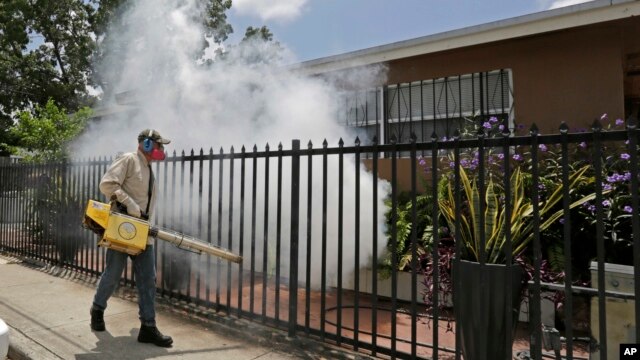CDC: Tick, Mosquito-Borne Infections Surge in US

FILE - A Miami-Dade County mosquito-control worker sprays around a home in the Wynwood area of Miami, Aug. 1, 2016.
The number of Americans sickened each year by bites from infected mosquitoes, ticks or fleas tripled from 2004 through 2016, with infection rates spiking sharply in 2016 as a result of a Zika outbreak, U.S. health officials said Tuesday.
The U.S. Centers for Disease Control and Prevention said that some 96,075 diseases caused by bites by mosquitoes, ticks and fleas were reported in 2016, up from 27,388 in 2004, in an analysis of data from the CDC's National Notifiable Diseases Surveillance System.
Infections in 2016 went up 73 percent from 2015, reflecting the emergence of Zika, which is transmitted by mosquitoes and can cause severe birth defects. Zika was the most common disease borne by ticks, mosquitoes and fleas reported in 2016, with 41,680 cases reported, followed by Lyme disease, with 36,429 cases, almost double the number in 2004.

FILE - A natural resources officer with Broward County Mosquito Control takes water samples decanted from a watering jug, checking for the presence of mosquito larvae in Pembroke Pines, Fla., June 28, 2016.
The increases may be a result of climate change, with increased temperatures and shorter winters boosting populations of ticks, mosquitoes and other disease-carrying creatures known as "vectors."
"It enables these ticks to expand to new areas. Where there are ticks, there comes diseases," said Lyle Petersen, director of the CDC's Division of Vector-Borne Diseases.
Warmer summer temperatures also tend to bring outbreaks of mosquito-borne illnesses, Petersen said.
While Zika stood out as the latest emerging threat in the report, it also showed a long-term increase in cases of tick-borne Lyme disease, which can attack the heart and nervous system if left untreated.
Researchers warned that their numbers likely do not include every case, as many infections are not reported.
These increases are due to many factors, including growing populations of the insects that transmit them and increased exposure outside of the United States by travelers who unknowingly transport diseases back home.
The CDC said more than 80 percent of vector-control organizations across the United States lack the capacity to prevent and control these fast-spreading, demanding illnesses.
Petersen said that federal programs are increasing funding for those organizations.




Comments
Post a Comment